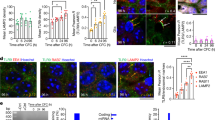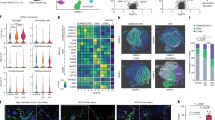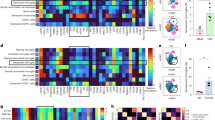Abstract
In Alzheimer's disease (AD) and other tauopathies, the tau protein forms fibrils, which are believed to be neurotoxic. However, fibrillar tau has been dissociated from neuron death and network dysfunction, suggesting the involvement of nonfibrillar species. Here we describe a novel pathological process in which caspase-2 cleavage of tau at Asp314 impairs cognitive and synaptic function in animal and cellular models of tauopathies by promoting the missorting of tau to dendritic spines. The truncation product, Δtau314, resists fibrillation and is present at higher levels in brains from cognitively impaired mice and humans with AD. The expression of tau mutants that resisted caspase-2 cleavage prevented tau from infiltrating spines, dislocating glutamate receptors and impairing synaptic function in cultured neurons, and it prevented memory deficits and neurodegeneration in mice. Decreasing the levels of caspase-2 restored long-term memory in mice that had existing deficits. Our results suggest an overall treatment strategy for re-establishing synaptic function and restoring memory in patients with AD by preventing tau from accumulating in dendritic spines.
This is a preview of subscription content, access via your institution
Access options
Subscribe to this journal
Receive 12 print issues and online access
$209.00 per year
only $17.42 per issue
Buy this article
- Purchase on Springer Link
- Instant access to full article PDF
Prices may be subject to local taxes which are calculated during checkout






Similar content being viewed by others
References
Spillantini, M.G. & Goedert, M. Tau pathology and neurodegeneration. Lancet Neurol. 12, 609–622 (2013).
Ballatore, C., Lee, V.M. & Trojanowski, J.Q. Tau-mediated neurodegeneration in Alzheimer's disease and related disorders. Nat. Rev. Neurosci. 8, 663–672 (2007).
Ittner, L.M. et al. Dendritic function of tau mediates amyloid-β toxicity in Alzheimer's disease mouse models. Cell 142, 387–397 (2010).
Yamada, K. et al. Neuronal activity regulates extracellular tau in vivo. J. Exp. Med. 211, 387–393 (2014).
Dixit, R., Ross, J.L., Goldman, Y.E. & Holzbaur, E.L. Differential regulation of dynein and kinesin motor proteins by tau. Science 319, 1086–1089 (2008).
Fath, T., Eidenmüller, J. & Brandt, R. Tau-mediated cytotoxicity in a pseudohyperphosphorylation model of Alzheimer's disease. J. Neurosci. 22, 9733–9741 (2002).
de Calignon, A. et al. Caspase activation precedes and leads to tangles. Nature 464, 1201–1204 (2010).
Gomez-Isla, T. et al. Clinical and pathological correlates of apolipoprotein E–ɛ4 in Alzheimer's disease. Ann. Neurol. 39, 62–70 (1996).
Rocher, A.B. et al. Structural and functional changes in tau-mutant mice neurons are not linked to the presence of NFTs. Exp. Neurol. 223, 385–393 (2010).
Menkes-Caspi, N. et al. Pathological tau disrupts ongoing network activity. Neuron 85, 959–966 (2015).
Santacruz, K. et al. Tau suppression in a neurodegenerative mouse model improves memory function. Science 309, 476–481 (2005).
Ramsden, M. et al. Age-dependent neurofibrillary tangle formation, neuron loss and memory impairment in a mouse model of human tauopathy (P301L). J. Neurosci. 25, 10637–10647 (2005).
Kopeikina, K.J. et al. Synaptic alterations in the rTg4510 mouse model of tauopathy. J. Comp. Neurol. 521, 1334–1353 (2013).
Rawlings, N.D., Waller, M., Barrett, A.J. & Bateman, A. MEROPS: the database of proteolytic enzymes, their substrates and inhibitors. Nucleic Acids Res. 42, D503–D509 (2014).
Hoover, B.R. et al. Tau mislocalization to dendritic spines mediates synaptic dysfunction independently of neurodegeneration. Neuron 68, 1067–1081 (2010).
Zempel, H., Thies, E., Mandelkow, E. & Mandelkow, E.M. Aβ oligomers cause localized Ca2+ elevation, missorting of endogenous tau into dendrites, tau phosphorylation and destruction of microtubules and spines. J. Neurosci. 30, 11938–11950 (2010).
Miller, E.C. et al. Tau phosphorylation and tau mislocalization mediate soluble Aβ oligomer-induced AMPA glutamate receptor signaling deficits. Eur. J. Neurosci. 39, 1214–1224 (2014).
Fasulo, L. et al. The neuronal microtubule-associated protein tau is a substrate for caspase-3 and an effector of apoptosis. J. Neurochem. 75, 624–633 (2000).
Cotman, C.W., Poon, W.W., Rissman, R.A. & Blurton-Jones, M. The role of caspase cleavage of tau in Alzheimer disease neuropathology. J. Neuropathol. Exp. Neurol. 64, 104–112 (2005).
Bergeron, L. et al. Defects in regulation of apoptosis in caspase-2-deficient mice. Genes Dev. 12, 1304–1314 (1998).
Isaac, J.T., Nicoll, R.A. & Malenka, R.C. Evidence for silent synapses: implications for the expression of LTP. Neuron 15, 427–434 (1995).
Liao, D., Hessler, N.A. & Malinow, R. Activation of postsynaptically silent synapses during pairing-induced LTP in CA1 region of hippocampal slice. Nature 375, 400–404 (1995).
Shalini, S., Dorstyn, L., Dawar, S. & Kumar, S. Old, new and emerging functions of caspases. Cell Death Differ. 22, 526–539 (2015).
Kumar, S., Kinoshita, M., Noda, M., Copeland, N.G. & Jenkins, N.A. Induction of apoptosis by the mouse Nedd2 gene, which encodes a protein similar to the product of the Caenorhabditis elegans cell death gene ced-3 and the mammalian IL-1β-converting enzyme. Genes Dev. 8, 1613–1626 (1994).
Tiwari, M. et al. A non-apoptotic role for CASP2/caspase-2: modulation of autophagy. Autophagy 10, 1054–1070 (2014).
Shalini, S. et al. Caspase-2 protects against oxidative stress in vivo. Oncogene 34, 4995–5002 (2015).
Upton, J.P. et al. IRE-1α cleaves select microRNAs during ER stress to de-repress translation of pro-apoptotic caspase-2. Science 338, 818–822 (2012).
Pozueta, J. et al. Caspase-2 is required for dendritic spine and behavioral alterations in J20 APP transgenic mice. Nat. Commun. 4, 1939 (2013).
Carroll, J.B. et al. Mice lacking caspase-2 are protected from behavioral changes, but not pathology, in the YAC128 model of Huntington disease. Mol. Neurodegener. 6, 59 (2011).
Lee, S. & Shea, T.B. Caspase-mediated truncation of tau potentiates aggregation. Int. J. Alzheimers Dis. 2012, 731063 (2012).
Wang, Y., Garg, S., Mandelkow, E.M. & Mandelkow, E. Proteolytic processing of tau. Biochem. Soc. Trans. 38, 955–961 (2010).
Dolan, P.J. & Johnson, G.V. A caspase-cleaved form of tau is preferentially degraded through the autophagy pathway. J. Biol. Chem. 285, 21978–21987 (2010).
Gamblin, T.C. et al. Caspase cleavage of tau: linking amyloid and neurofibrillary tangles in Alzheimer's disease. Proc. Natl. Acad. Sci. USA 100, 10032–10037 (2003).
Spires-Jones, T.L., Stoothoff, W.H., de Calignon, A., Jones, P.B. & Hyman, B.T. Tau pathophysiology in neurodegeneration: a tangled issue. Trends Neurosci. 32, 150–159 (2009).
Zhang, Z. et al. Cleavage of tau by asparagine endopeptidase mediates the neurofibrillary pathology in Alzheimer's disease. Nat. Med. 20, 1254–1262 (2014).
Abraha, A. et al. C-terminal inhibition of tau assembly in vitro and in Alzheimer's disease. J. Cell Sci. 113, 3737–3745 (2000).
Yoshiyama, Y. et al. Synapse loss and microglial activation precede tangles in a P301S tauopathy mouse model. Neuron 53, 337–351 (2007).
Davies, P. Characterization and use of monoclonal antibodies to tau and paired-helical-filament tau. Methods Mol. Med. 32, 361–373 (2000).
Hunsberger, H.C. et al. Effect size of memory deficits in mice with adult-onset P301L tau expression. Behav. Brain Res. 272, 181–195 (2014).
Westerman, M.A. et al. The relationship between Aβ and memory in the Tg2576 mouse model of Alzheimer's disease. J. Neurosci. 22, 1858–1867 (2002).
Wolfer, D.P., Madani, R., Valenti, P. & Lipp, H.P. Extended analysis of path data from mutant mice using the public domain software Wintrack. Physiol. Behav. 73, 745–753 (2001).
Lesné, S. et al. A specific amyloid-β protein assembly in the brain impairs memory. Nature 440, 352–357 (2006).
Wang, X. et al. Loss of sorting nexin 27 contributes to excitatory synaptic dysfunction by modulating glutamate receptor recycling in Down's syndrome. Nat. Med. 19, 473–480 (2013).
Acknowledgements
Sources of funding for this study include the US National Institutes of Health (NIH) (EUREKA grant no. R01-NS63214 (K.H.A.) and R01-NS79374 (K.H.A.)), the T. and P. Grossman Family Foundation (K.H.A.), B. Grossman (K.H.A.) and K. Moe (K.H.A.). We thank P. Davies (Albert Einstein College of Medicine) for the antibodies Alz-50, MC-1 and CP-13, as well as B. Roth (University of North Carolina at Chapel Hill) for the pAAV-CaMKIIa-EGFP vector. We are grateful to the participants of the Memory and Aging Project, as well as the staff and director (D. Bennett) of the Rush Alzheimer's Disease Center (grant no. R01-AG17917 (D. Bennett)). We thank L. Kemper, K. Leinonen and E. Steuer for excellent assistance with mouse breeding, genotyping and behavioral tests, M. Kuskowski for help with statistical analyses, and C. Wilmot, D. Liao, M. Koob and M. Walters for valuable advice and encouragement.
Author information
Authors and Affiliations
Contributions
K.H.A. conceived and supervised the project, designed the experiments and wrote the manuscript; X.Z. designed and performed the experiments and wrote the manuscript; L.A.K. designed and performed the behavioral experiments; B.S. performed the electrophysiological experiments and prepared the postsynaptic fractions; C.H. performed the behavioral experiments; K.Z. performed hippocampal volume quantification; M.R. contributed to the initial identification of Δtau314; and J.C. contributed to the behavioral experiments.
Corresponding author
Ethics declarations
Competing interests
The authors declare no competing financial interests.
Supplementary information
Supplementary Text, Figures and Tables
Supplementary Figures 1–12 and Supplementary Table 1 (PDF 2550 kb)
Rights and permissions
About this article
Cite this article
Zhao, X., Kotilinek, L., Smith, B. et al. Caspase-2 cleavage of tau reversibly impairs memory. Nat Med 22, 1268–1276 (2016). https://doi.org/10.1038/nm.4199
Received:
Accepted:
Published:
Issue Date:
DOI: https://doi.org/10.1038/nm.4199
This article is cited by
-
Exploring the significance of caspase-cleaved tau in tauopathies and as a complementary pathology to phospho-tau in Alzheimer’s disease: implications for biomarker development and therapeutic targeting
Acta Neuropathologica Communications (2024)
-
Targeting synapse function and loss for treatment of neurodegenerative diseases
Nature Reviews Drug Discovery (2024)
-
Differential interactome mapping of aggregation prone/prion-like proteins under stress: novel links to stress granule biology
Cell & Bioscience (2023)
-
Tau: a biomarker of Huntington’s disease
Molecular Psychiatry (2023)
-
Amyloid β-based therapy for Alzheimer’s disease: challenges, successes and future
Signal Transduction and Targeted Therapy (2023)



